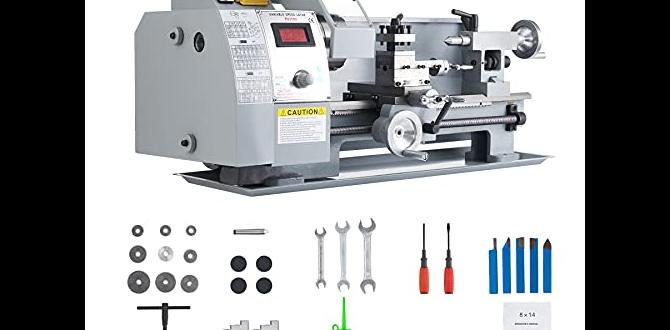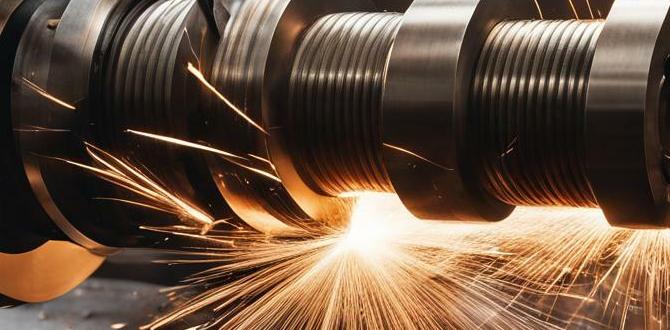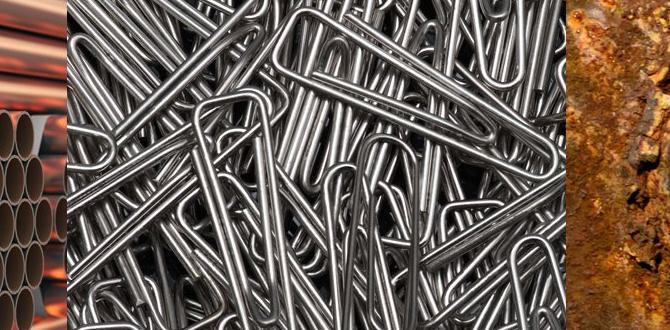For cutting Aluminum 6061 with a 1/8″ carbide end mill, a 2-flute, standard length end mill running at 18,000-24,000 RPM with a feed rate of 10-20 IPM (inches per minute) and a depth of cut of 0.010″-0.030″ is a reliable starting point. Choosing the right end mill and setting your machine correctly is key to achieving smooth cuts and reducing chatter.
Hey there, shop mates! Daniel Bates here from Lathe Hub. Ever tried to mill some shiny Aluminum 6061 and ended up with a noisy, vibrating mess or, worse, a broken tool? It’s a common frustration, especially when you’re just getting your hands dirty with machining. That little 1/8″ carbide end mill can be an amazing tool for detail work, but picking the wrong one or setting up your machine incorrectly for aluminum can turn a simple job into a headache. Don’t worry, though! We’re going to break down exactly what you need to know to get those clean, chatter-free cuts. We’ll cover everything from choosing the right mill to dialing in your machine settings. Let’s get your aluminum projects looking sharp!
Why Aluminum 6061 and a 1/8″ End Mill?
Aluminum 6061 is a fantastic material for hobbyists and professionals alike. It’s strong, lightweight, and, importantly, easy to machine. This makes it a go-to for everything from custom brackets and enclosures to artistic creations. When you need to add intricate details, slots, or pockets, a small diameter end mill is essential. The 1/8″ size is particularly popular because it allows for fine features and tight tolerances that larger tools just can’t achieve.
However, working with aluminum and small tools presents its own set of challenges. Aluminum can be “gummy,” meaning it tends to stick to cutting tools rather than cleanly shearing off. This can lead to tool loading, poor surface finish, and that dreaded chatter. Combine a gummy material with a small tool, and you’ve got a recipe for disaster if you don’t get your settings right. That’s where understanding the specifics of your carbide end mill becomes crucial.
Choosing the Right 1/8″ Carbide End Mill for Aluminum
Not all 1/8″ carbide end mills are created equal, especially when it comes to machining aluminum. Here’s what to look for to ensure you pick a winner:
Number of Flutes
2 Flutes: Generally, for aluminum, a 2-flute end mill is the sweet spot. The wider chip valleys (guts) created by fewer flutes help clear out the aluminum chips more effectively. This is vital because packed chips can cause tool breakage and a poor finish.
3 or 4 Flutes: While great for steel and other harder materials due to their ability to take lighter cuts and provide a better surface finish, these can sometimes pack up with aluminum chips in a smaller diameter like 1/8.
End Mill Geometry
Coated vs. Uncoated: For aluminum, a bright, uncoated carbide end mill is often preferred. Coatings can sometimes increase friction or become gummy with aluminum. However, specialized coatings like ZrN (Zirconium Nitride) can also perform very well by reducing friction and preventing material buildup. If you’re unsure, start with an uncoated bright finish.
Helix Angle: A higher helix angle (often 30-45 degrees) is generally better for aluminum. This higher angle “thio” the cut, which helps to shear the material more cleanly and evacuate chips more efficiently upwards and out of the cut.
Flat vs. Ball End Mill: For general pocketing and slotting, a flat-bottomed end mill (a “square” or “flat” end mill) is used. If you need to create rounded internal corners or mill 3D shapes, a ball end mill is the choice. For this guide, we’re focusing on achieving good cuts with a standard flat end mill.
Length and Shank
Standard Length: For a 1/8″ end mill, a standard length is usually sufficient for most aluminum 6061 machining tasks on hobbyist machines. An “extended reach” or “long flute” end mill offers no real advantage for this size and material and can actually increase the risk of deflection and chatter due to its inherent flexibility.
Shank: Most 1/8″ end mills will come with a 1/8″ shank. Ensure you have the correct collet size for your milling machine or CNC spindle to hold it securely.
Material
Carbide: For aluminum, solid carbide end mills are highly recommended. They offer superior rigidity and heat resistance compared to High-Speed Steel (HSS), allowing for faster cutting speeds and cleaner cuts.
Key Machining Parameters for 1/8″ End Mill on Aluminum 6061
Getting the settings right on your machine is just as important as picking the right tool. Here’s a breakdown of the parameters to consider:
Spindle Speed (RPM)
The rotational speed of your cutting tool. For a 1/8″ carbide end mill in Aluminum 6061, a good starting range is 18,000 to 24,000 RPM.
Why this range? Aluminum machines well at higher speeds. Carbide tools can handle the heat generated. Lower speeds can lead to rubbing and chip recutting, while excessively high speeds might create too much heat or chatter.
Feed Rate (IPM – Inches Per Minute)
The rate at which the tool advances into the material. For a 1/8″ carbide end mill on Aluminum 6061, a starting point is typically 10 to 20 IPM.
Why this range? This speed aims for effective chip formation and evacuation without overloading the tool. Too slow a feed rate, and you’ll rub and melt the aluminum onto the tool. Too fast, and you risk tool breakage or a poor surface finish.
Depth of Cut (DOC)
The amount of material the end mill removes in each pass. For a 1/8″ end mill in Aluminum 6061, start conservatively:
0.010″ to 0.030″.
Why this range? Smaller end mills are not as rigid as larger ones. Taking shallow depths of cut preserves tool life and prevents deflection, which is a major cause of chatter. For roughing, you might push this slightly, but for fine detail and finishing, keep it light.
Stepover Width
This is the amount of lateral movement the end mill makes between passes when milling a larger area. For clearing pockets, a stepover of
30-50% of the tool diameter (0.0375″ to 0.0625″ for a 1/8″ end mill) is common. For finishing passes, you might use a smaller stepover for a smoother surface.
Coolant/Lubrication
While not always strictly necessary for aluminum in a hobbyist setting if you’re watching your chip formation, using a cutting fluid or lubricant can significantly improve cutting performance.
Mist Coolant: A fine mist of specialized cutting fluid is excellent for aluminum. It lubricates the cut, cools the tool, and helps float chips away.
Cutting Fluid/Wax: A small amount of cutting wax or a dedicated aluminum cutting fluid applied to the tool or workpiece can also help reduce friction and prevent chip welding.
Air Blast: Sometimes, a strong blast of compressed air directed at the cutting zone can help clear chips effectively.
Optimizing for Reduced Chatter
Chatter – that annoying vibration and ringing sound – is the enemy of good machining. It leads to poor surface finish, tool breakage, and machine wear. Here’s how to combat it when using your 1/8″ end mill on Aluminum 6061:
Rigidity is Key:
Tool Holder: Use a high-quality collet chuck or end mill holder that grips the shank of the end mill tightly and runout is minimized. Avoid set-screw type holders if possible, as they can induce runout.
Workholding: Make sure your workpiece is clamped down firmly and won’t move. A loose workpiece is a prime contributor to chatter.
Shallow Cuts: As mentioned, shallow depths of cut and conservative stepovers are your best friends.
Tool Selection:
Sharp Tool: A dull end mill will rub, generate heat, and chatter. Always start with a sharp tool.
Correct Flute Count: Again, 2 flutes are usually best for aluminum.
Machine Settings:
Spindle Balance: Ensure your spindle is balanced, especially at high RPMs.
Feed Rate: Experimenting with your feed rate. Sometimes a slightly faster feed can “outrun” the chatter.
Backlash: If you’re using a manual machine, minimize backlash in your feed screws. A CNC machine with properly calibrated ball screws will generally have less backlash impact.
Material Properties: Ensure you are actually working with Aluminum 6061. Softer aluminums can be “gummier.”
Machining Steps: A Beginner’s Guide
Let’s walk through a typical milling operation. We’ll aim to cut a simple slot or pocket.
Tools and Materials Needed
Milling Machine (Manual or CNC) or a sturdy Router with a milling collet setup
1/8″ 2-Flute Carbide End Mill (Uncoated Bright Finish or suitable aluminum coating)
Aluminum 6061 workpiece
Clamps (e.g., machinist clamps, vise)
Measuring tools (calipers, ruler)
Safety glasses and hearing protection
Optional: Mist coolant system, cutting fluid, edge finder (for CNC)
Step-by-Step Process
1. Safety First!
Always wear safety glasses.
Wear hearing protection, especially at higher RPMs.
Keep hands and clothing away from the moving tool and workpiece.
Ensure you know how to perform an emergency stop on your machine.
2. Secure the Workpiece
Place your Aluminum 6061 block on the milling machine table.
Use clamps or a vise to secure it firmly. Ensure the clamping will not interfere with your milling path. The workpiece should be absolutely immobile.
3. Set Up the End Mill
Install the 1/8″ carbide end mill into your machine’s collet or tool holder.
Ensure it’s seated properly and tightened securely.
Minimize the overhang (how much of the end mill sticks out past the collet) to maintain rigidity – aim for no more than 1/2 inch for this size.
4. Establish Your Zero Point (Origin)
Manual Machine: You’ll manually find the edge of your workpiece or a datum point using the machine’s handwheels and a dial indicator or by “touching off.
CNC Machine: Use an edge finder or probe to accurately locate your X, Y, and Z zero points for the program. It’s crucial to set your Z-zero to the top surface of the aluminum.
5. Program Your Cut (CNC) or Plan Your Moves (Manual)
CNC: Load your G-code program. Double-check the speeds, feed rates, depths of cut, and toolpath.
Manual: Carefully note down the settings on your machine’s DRO (Digital Readout) or dials for your starting point and the desired slot/pocket dimensions.
6. Set Your Machining Parameters
Spindle Speed: Set your spindle to the target RPM (e.g., 20,000 RPM).
Feed Rate: For CNC, this will be programmed. For manual, you’ll control this with the handwheel. Start with 10-20 IPM.
Depth of Cut (DOC): Set your first pass to a shallow depth (e.g., 0.015″). You will incrementally increase this for subsequent passes if desired.
7. Begin the Cut
Engage Spindle: Turn on the spindle.
Apply Coolant (if used): Turn on your mist coolant or apply lubricant.
Plunge (if necessary): If you need to go into the material from the top surface, slowly plunge the end mill down to the set depth.
Feed into Material:
CNC: Start the program.
Manual: Slowly and steadily turn the handwheel to feed the end mill horizontally into the aluminum. Listen to the sound of the cut. A smooth, slicing sound is good. A high-pitched squeal or a grinding noise indicates an issue (too fast, too slow, dull tool, or chip buildup).
Manage Chips: Ensure chips are being cleared. If they seem to be packing, you may need to increase feed rate slightly, reduce depth of cut, or use a stronger air blast/coolant.
8. Subsequent Passes
Once the first pass is complete, retract the tool.
Incrementally increase the depth of cut (e.g., by another 0.015″ to 0.030″) for the next pass.
Repeat Step 7 until your desired depth is reached. For a finishing pass, you might take a very light cut (e.g., 0.005″) at a slightly slower feed rate for a super smooth surface.
9. Inspect Your Work
After the final pass, retract the tool and clean the workpiece.
Measure your slot or pocket to ensure it’s within your desired tolerances.
Examine the surface finish. It should be relatively smooth with minimal tearing or burring.
Troubleshooting Common Issues
| Issue | Potential Cause | Solution |
| :——————- | :————————————————————————— | :—————————————————————————————————————————————– |
| Chatter/Vibration | Tool overhang too great, dull tool, too aggressive depth of cut, tool flex. | Reduce tool overhang, use a sharp 2-flute end mill, shallower depth of cut, increase feed rate slightly, ensure rigid workholding. |
| Poor Surface Finish | Rubbing (feed too slow), chip recutting, workpiece vibrating, dull tool. | Increase feed rate, use more aggressive chip evacuation (coolant/air), add a finishing pass with lighter depth of cut, sharpen or replace tool. |
| Tool Loading/Gummy| Feed rate too slow, incorrect speeds, dull tool, poor chip evacuation. | Increase feed rate towards the higher end of the range, ensure adequate cooling/lubrication, use a sharp 2-flute end mill designed for aluminum. |
| Broken Tool | Aggressive depth of cut, too fast feed rate, unexpected hard spot in material. | Reduce depth of cut, reduce feed rate initially, ensure workpiece is securely held, check material for inconsistencies. |
| Tool Deflection | Shallow depth of cut not achieved, high radial cutting forces from wide stepover. | Use shallow radial and axial depths of cut. Ensure tool is running true in the spindle. |
Understanding Chip Formation
One of the best ways to diagnose machining problems is to simply look at the chips being produced.
Small, Dusty Chips: This often indicates you’re not removing enough material, possibly due to a feed rate that’s too slow or a depth of cut that’s too shallow for the RPM. This can lead to rubbing and a poor finish.
Long, Stringy Chips: In aluminum, this can sometimes be good, indicating a clean shearing action. However, if they are too long and wrap around the tool, they can cause chip packing. Ensuring proper chip evacuation is key.
Small, Welded Chips: If your chips look like little nuggets welded together or to the tool flutes, this is a sign of chip welding, often caused by rubbing, insufficient cooling/lubrication, or a feed rate that’s too slow.
Broken, Clean Chips: These are often ideal. They indicate a good balance of speed, feed, and rake angle, where the material is shearing cleanly without excessive friction or buildup.
Getting the chip formation right is a critical skill for any machinist and is a direct indicator of whether your parameters are optimized.
Advanced Tips for Aluminum 6061
Once you’re comfortable with the basics, here are a few things to consider:
Feeds and Speeds Calculators
Many online resources and machining software provide feeds and speeds calculators. While they are excellent starting points, remember that the specific geometry of your end mill, the rigidity of your machine, and the exact alloy variant of your aluminum can influence the optimal settings. Always use calculators as a guide and be prepared to make slight adjustments based on what you hear and see at the machine. A good one to check for general guidance on end mills is a resource from a reputable manufacturer like: Sandvik Coromant Guidance (though this link goes to a general tool search, their site has extensive resources).
Finishing Passes
For parts requiring a very high-quality surface finish, a dedicated finishing pass is essential.
Parameters: Use a very shallow depth of cut (e.g., 0.005″ to 0.010″). Increase the spindle speed slightly and decrease the feed rate to be closer to the lower end of your acceptable range (e.g., 10-15 IPM for a 1/8″ end mill).
**Stepover





